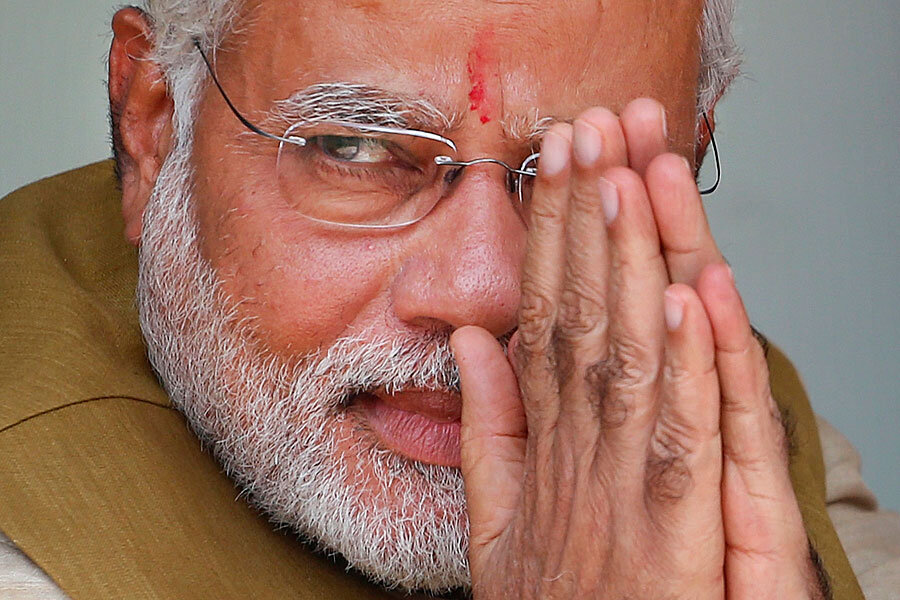Can Modi's victory bring better US-India ties? It depends on US, say analysts.
Loading...
| Washington
When President Obama visited India in 2010 he declared the bilateral relationship between the world’s oldest and largest democracies a “defining partnership of the 21st century.”
Ties only went downhill from there. A range of factors took relations from promising to languishing: from US irritation over Indian trade violations and fading White House interest to a marked inward turn by India and even a diplomatic row set off by the arrest last December of an Indian diplomat in New York.
The landslide victory announced Friday of India’s Hindu nationalist BJP (Bharatiya Janata Party) in national elections is an opportunity to “reset” the relationship between Washington and New Delhi and to deliver on the promise Mr. Obama spoke of four years ago, officials and South Asia analysts say. The BJP is expected to vigorously pursue pro-growth economic measures and to reaffirm India as an Asian power through a more robust foreign policy – two steps the US can work with to further its and the region’s interests, analysts say.
“The election of a new government, one that will be formed by the BJP, offers an opportunity to reinvigorate a relationship that has stagnated over the last several years,” says Lisa Curtis, a senior research fellow in South Asian affairs at the Heritage Foundation in Washington. “This is a chance for the US and India to move forward on their many common strategic and economic interests.”
But before relations can shift from the doldrums to the fast track, the US will have to come to terms with the leader of the BJP, Narendra Modi, who is all but certain to be named India’s next prime minister.
Mr. Modi may have come out of the elections the new face of the hopes and aspirations of 1.2 billion Indians, but he has been effectively blacklisted by the US for nearly a decade.
The US refused to issue Modi a visa in 2005 on charges that he was either involved in fomenting or did nothing to quell deadly sectarian riots that in 2002 shook the state of Gujarat where he was chief minister. The riots claimed the lives of more than 1,000 mostly Muslim victims, and made Modi the target of international human rights groups.
On Friday the Obama administration congratulated Modi on his party’s victory, with White House spokesman Jay Carney insisting that “the prime minister of India will be welcomed in the United States.” In a subsequent statement, the White House said Mr. Obama called Modi to say he looks forward to working closely with him to “fulfill the extraordinary promise of the US-India strategic partnership.”
At the State Department, spokeswoman Jen Psaki said, “We congratulate Narendra Modi and the BJP on its victory in … India’s historic national election,” which she noted had seen “more voters cast their ballots freely and fairly than in any election in human history.”
As for Modi, she said that “as head of government” he “would be eligible for an A-1 visa,” which is the level of document issued to government leaders.
But it will take more of a reaching-out and enthusiasm than that to get relations to the level of a “defining partnership,” some officials, analysts, and representatives of the Indian-American community say.
The Obama administration should take note of the all-community-encompassing campaign that Modi ran as assurance that the new leader intends to serve all of India’s citizens, says Heritage’s Ms. Curtis.
“Obama should reach out to Modi and demonstrate that he’s not going to give him the cold shoulder over the issue of the Gujarat riots,” she says. “The US needs to take into account that Modi did not get involved in communal politics in the campaign.”
Others note that several probes launched after the Gujarat riots resulted in Modi’s exoneration – even though a number his cabinet ministers were found guilty of inciting violence.
One idea being promoted by some in the Indian-American community is that Obama should invite Modi to the White House in September, when as India’s leader he would be in New York for the annual United Nations General Assembly meeting.
“President Obama must seize this opportunity of the UN General Assembly to invite Mr. Modi and give leadership to a relationship which seems to be languishing presently,” says Sanjay Puri, chairman of the US India Political Action Committee, USINPAC.
Curtis says there are a number of opportunities on the near horizon for the US to demonstrate its willingness to work with a Modi-led India, including a trilateral US-India-Japan meeting set for June. That meeting should allow the Obama administration to advance the president’s “Asia pivot” by reinforcing the place it envisions for India, she says.
But well before then, Obama should make it clear to India that the US is ready and anxious to work with its new leader, Curtis says. “The onus is on the US to reach out to Modi and demonstrate the potential it sees for this relationship.”






